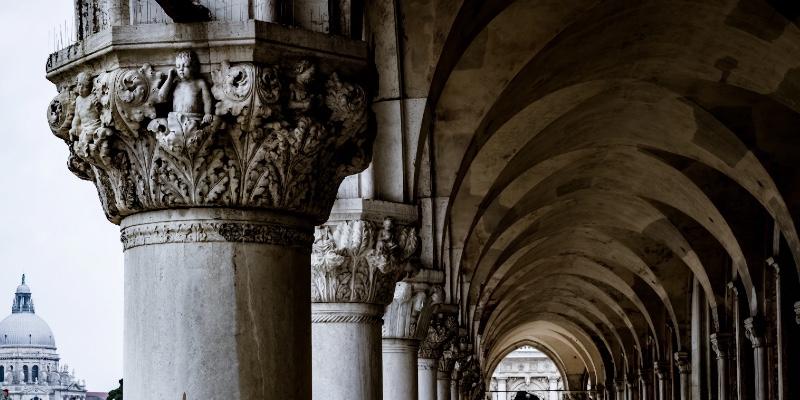During the Middle Ages and the Renaissance, Venice was the richest and most powerful nation in Europe. You’d be forgiven for thinking that title would go to one of the larger nations like England or France, but through a combination of physical location, a robust mercantile economy, and military – largely naval – prowess, it was Venice that rose above the rest. And certainly part of the reason for Venice’s stability, security, and economic success was due to the fact that, unusually for Europe at this time in history, it was a republic. Oligarchy might be a more technically accurate term, as the only people allowed to serve in government were men above the age of twenty-five from a set group of patrician families. And the Venetians structured their government specifically to avoid corruption and to prevent one man, family, or faction from growing too powerful. The figurehead of the government, the doge, was elected for life, but he was certainly no absolute authority, and his powers were limited and checked by the legislative bodies he oversaw.
This system seems to have worked relatively well, as throughout its history the Venetian Republic did not see the same level of internal political turmoil as other nations on the Italian peninsula such as Florence, Naples, and Rome, to name a few. And the government body largely responsible for maintaining both Venice’s international prominence and domestic security was known as the Council of Ten.
The Council of Ten was a subset of the Venetian senate that dealt with intelligence and espionage, among other things – including ordering the occasional assassination. They had entire teams of codebreakers and codemakers within the Doge’s Palace – the building that housed not only the living quarters of the doge and his family, but also all the offices of the government – who worked to both decode the ciphers of rival nations and to create new codes for Venetian spies and other assets abroad to use to communicate back to the council.
Men elected to the Ten served a term of one year, and then could never serve on the council again. The Ten was led at any given time by the Tre Capi, or Three Heads: three men chosen from among the Ten to lead for a period of one month during their term. During that month, the Capi were forbidden from leaving the Doge’s Palace, in order to prevent them from becoming potentially corrupted by any outside influence.
So, as you may have guessed, Venice was constantly on the lookout for acts of treason or betrayal: from rival nations looking to steal intelligence from Venice’s Arsenale, which during its prime could produce one warship a day; to foreign merchants trying to discover the method for making Murano glass, a trade secret that gave Venice a monopoly on fine glass. Upon the fall of Constantinople to the Turks, the Ottoman Empire became Venice’s biggest rival for domination of the Mediterranean (as well, as, ironically, one of their most lucrative trading partners – the Venetians always had an eye for profit.) In addition, prior to unification, the various nations of the Italian peninsula – always shifting allegiances amongst themselves – were vulnerable to exploitation by some of those larger nations in Europe, notably France and Spain. Venice was exempt from such attention for a time, protected by its wealth and military might, but as the Renaissance drew to a close and mercantile interests shifted from the east to the colonization of North America, Venice’s fortunes and influence began to decline.
Certainly, then, one can see how the Venetian government might have felt at times – whether correctly or not – surrounded by enemies on all sides. And it was one of the primary jobs of the Council of Ten to detect, assess, and eliminate – if necessary – any threats to the republic. But how did they become aware of such threats?
Well, the same way any secretive government body would, of course: espionage, bribery, and the like. But there was one other way that the Council of Ten sought information, what we might consider an early modern tip line, of sorts: the bocche dei leoni, or lion’s mouths.
The bocche dei leoni were, in essence, mail slots scattered around the city. Often carved into the shape of a lion – an homage to the symbol of Venice, the winged lion of St. Mark – the mouth was open to receive letters. And not just any letters: denunciations.
Venetians were encouraged to report on their fellow citizens should they learn of any illegal and potentially treasonous activity in their midst. A person could write down the name of someone involved in a crime against the state and whatever information they had about said crime. Then, crucially, they needed to sign it if they were accusing a private individual; in order to discourage petty score-settling and the like, the only anonymous denunciations that were considered were those against public officials. The letter would then be collected and reviewed by the Council of Ten.
It’s impossible to know how much viable intelligence was received via the bocche di leoni – one of the things about shadowy government agencies, after all, is that they tend not to record everything they know and do. But the continued existence of these sinister mailboxes certainly suggests that the Ten found the information they received through them useful, at least sometimes.
And what happened to those suspected by the Ten of committing treason? Well, as you might have guessed, it wasn’t pretty. Traitors would be held in the cells of the Doges Prison, the lower cells of which would often flood during the acqua alta, or high tide. And if and when the Ten wanted information from someone, they were not shy about using torture. The prison contained torture chambers as well, and a favorite of the Ten was called the strappado: a rope or cord looped through a ring on the ceiling, connected to a hand-operated crank on the wall. The subject’s arms would be tied behind their back and their wrists attached to the rope coming down from the ceiling. When the crank was turned, the rope would lift the person up by their bound wrists behind their back, dislocating their shoulders and causing tremendous pain. They could be raised and lowered at the discretion of the torturer, depending on the answers given. Obviously, the longer this went on, the more likely there was to be permanent damage to joints, tissue, and bones.
Execution for convicted criminals was also not uncommon. The sentence for traitors was to be hanged between the two columns on the Piazzetta outside the Doge’s Palace. To this day, Venetians consider it bad luck to walk between those two columns.
Where is the line between protecting a nation’s citizens and simply protecting that nation’s power? It’s a question posed almost ceaselessly by both history and current events. In the case of the Venetian Republic, the state was protected by a ruthless body not afraid of getting its hands dirty. That Republic remains one of the longest lasting governments in human history. So were the actions the Council of Ten took on its behalf justified? I’ll let you decide.
***


















